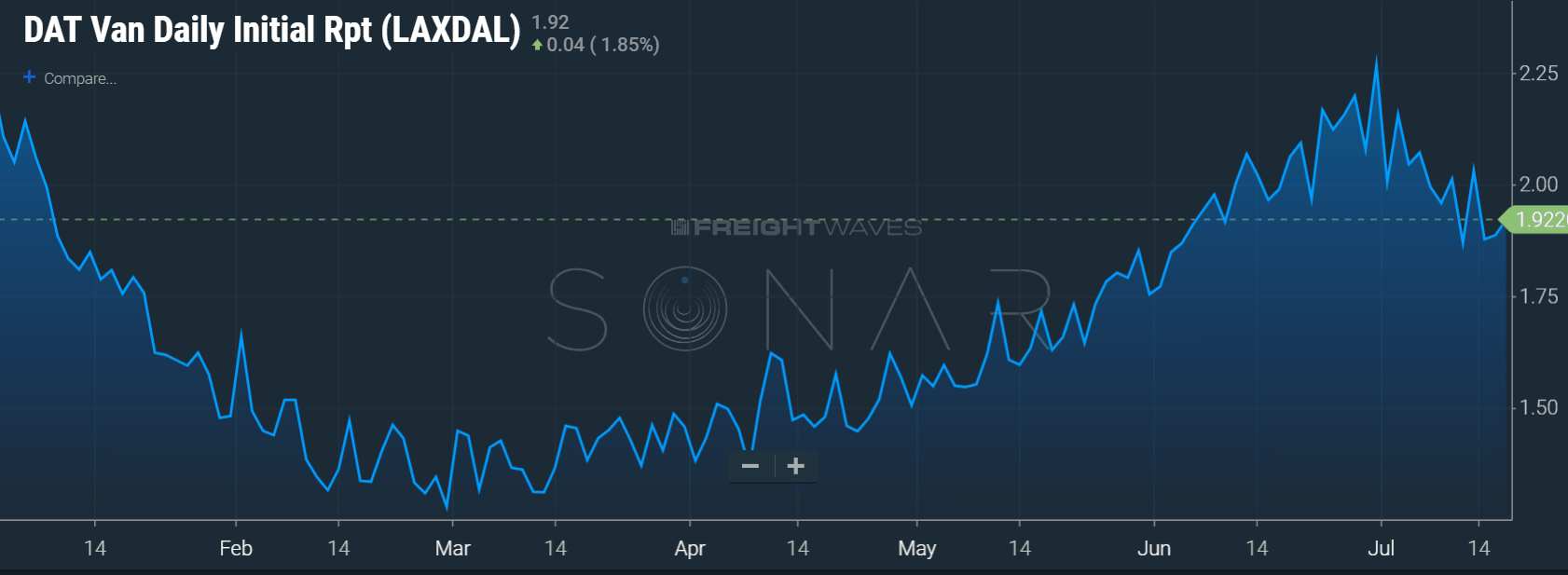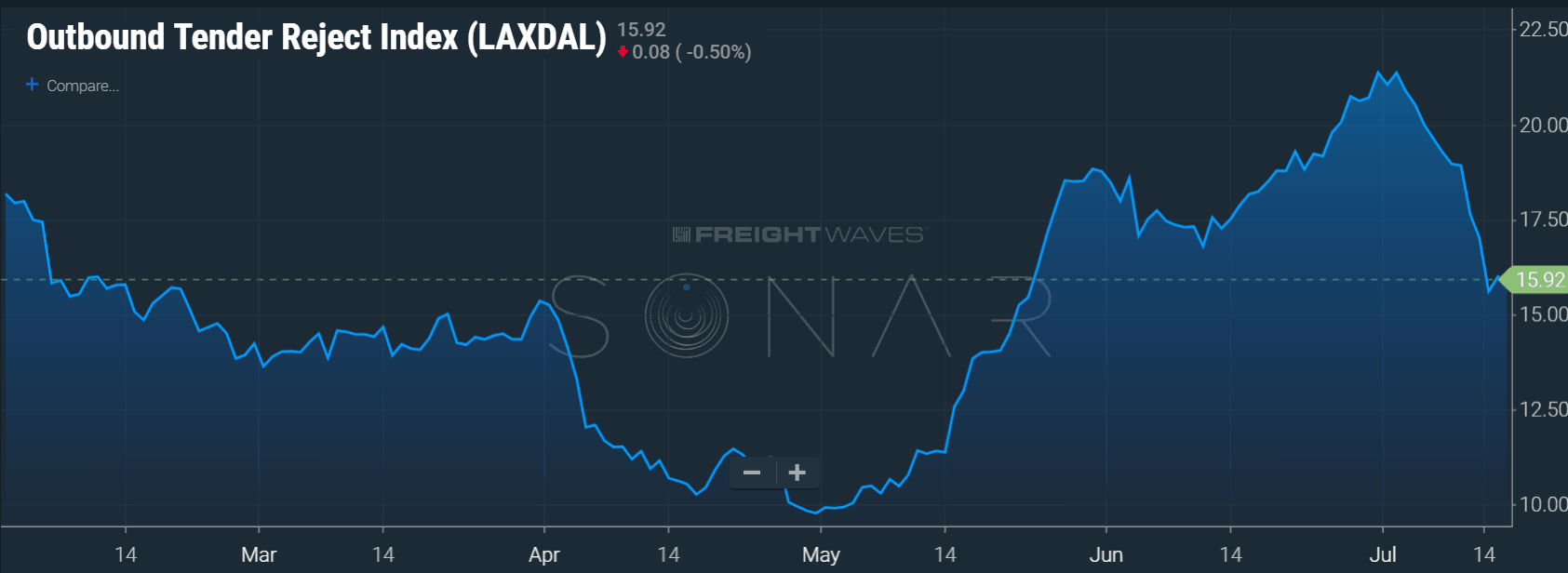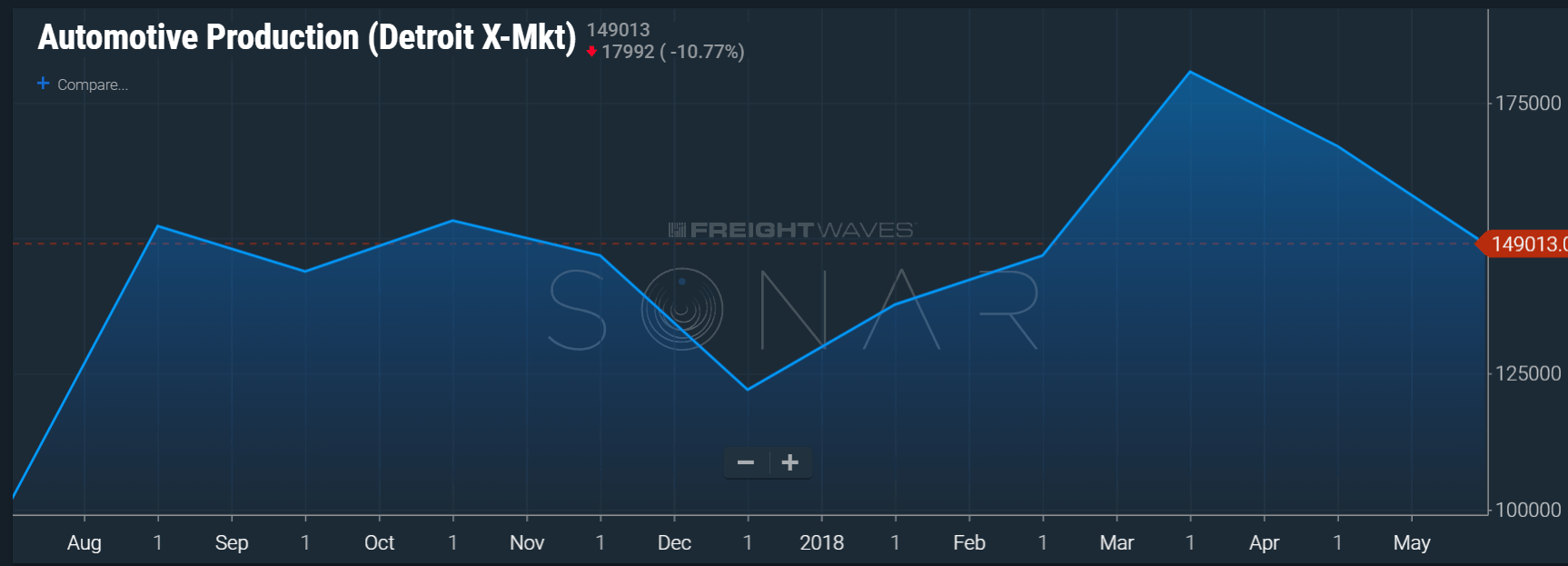Over the course of the previous weeks we have added several new data points to the SONAR platform. Since the July 9th release several economic indicators that are relevant to the transportation industry have been added to help give perspective on the broader economic health and balance the data. Some of the numbers have direct implications on transportation such as housing starts and automotive production. To see a complete list of all available data and explanations click here.
This week we have added some of the most useful data to date. We have also made some big improvements to the user experience. DAT lane pricing and tender rejections by lane have been added this week along with several new economic indicators.
What’s new in SONAR this week
DAT Indices
We have added DAT indices for 7 of the most trafficked lanes in the country. They represent 22% of the total truckload volume and directly influence 80% of the remaining capacity in the U.S. These indices are released by DAT on a 4 business-day lag, updated each business day.
These indices have been scrubbed to ensure the cleanest and most accurate representation of spot market rates.
This index has been developed by DAT to support the launch of trucking freight futures, in partnership with Nodal and FreightWaves. The DAT index is not a replacement for DAT’s Rateview and does not provide granular rate data on lanes outside of the benchmark seven that will be used for futures contract settlement.
Accessorials, hazmat, and fuel have all been removed as well as any outlying data.
The DAT lane index is the ultimate representation of how to measure activity in the spot market as well as being the most understood. Studying historical trends of the index can also give participants in the market a sense of directional volatility.
The lanes are as follows:
Los Angeles to Seattle Van (LAXSEA)
Seattle to Los Angeles Van (SEALAX)
Los Angeles to Dallas Van (LAXDAL)
Dallas to Los Angeles Van (DALLAX)
Chicago to Atlanta Van (CHIATL)
Atlanta to Philadelphia Van (ATLPHL)
Philadelphia to Chicago Van (PHLCHI)
Example: If a user wanted to look at the current DAT lane indices for Los Angeles to Dallas they would type DATVF.LAXDAL and see the following:

Tender rejection index by lane
Long anticipated tender rejection indices (TRI) by lane have been added to give the user a more granular view of the popular TRI stat. Lanes with enough volume are now available to view by typing OTRI.lane.
Example: A user wants to see tender rejection rates for Los Angeles to Dallas. They would type OTRI.LAXDAL and see:

The lanes will also be offered as weekly, bi-weekly, and monthly changes as we have available for the market and equipment type versions of the TRI.
Example: To get the L.A. to Dallas weekly, bi-weekly, and monthly change you would type:
OTRIW.LAXDAL, OTRIF.LAXDAL, and OTRIM.LAXDAL.
With the addition of lane data and the deltas, SONAR users will be able to target specific areas with more precision when making market evaluations.
Automotive production and housing starts
Last week we added automotive production and housing start information to SONAR. These are two extremely relevant monthly indicators to freight markets due to their direct measurement of materials that have large impact on freight flows due to their volume.
Automotive production is the number of light vehicles produced in a month in a market. Automotive production not only gives you insight into the economy of the U.S. but also gives you insight into how much the pre-production parts are impacting freight markets.
Example: If a user wants to see the automotive production in Detroit they would type AUTO.DTW and get:

Along similar lines housing starts is an important economic indicator, but it also gives insight into the demand for lumber, and raw materials needed for house construction. You can also get a predictive look into furniture and appliance demand. Housing starts are available on a national level. Housing starts are defined as the number of houses begun for construction (listed in thousands) in a month. They are offered in single family (SFAM) and multi-family (MFAM) granularity.
Example: A user wants to see single family housing starts in the country they would type SFMA.USA and see:

In addition to the new data we have improved the user experience. Significant improvement to the search feature have been made along with the following updates:
Chart
- “View Symbol Metadata” functionality implemented
- “Add Symbol to Watchlist” functionality implemented. For the current release, clicking “Add Symbol to Watchlist” spawns a new watchlist with that symbol. In a future release, a user will be able to add a symbol to an existing watchlist in addition to spawning a new watchlist with that symbol
- Added option to compare symbols in “Absolute” or “Relative” mode. In Absolute mode, the y-axis shows the actual values. In Relative mode, the y-axis shows percentages. This setting is accessible under the “Display” menu in the chart.
- User can now specify a custom date range (via the box to the right of “All”).
- The height of the search results box has been limited based on the search results (not full height unless necessary)
- Removed open/high/low/close from the rectangle at the top of the chart (which can be toggled on and off by clicking the chat icon in the top right of the chart)
- We made a small coding change to fix the issue of the indefinite spinning circle that would sometimes happen when loading a symbol for the first time on a day. I have not experienced this issue since we made this code change
- Removed the “share” link
Symbol Searching (Chart and Watchlist)
- Search results are now returned in alphabetical order. This also means that, if what you search for is an exact match, this exact match should be displayed first (e.g. try OTRI.CHI)
- To improve performance and usability given the addition of several new SONAR Indices, the maximum number of results returned in a search query has been set to 25
- To further improve performance and usability, search queries are sent on a 300 millisecond delay. For example, say a user is trying to search for OTRI.CHI. As soon as they type “o”, a 300 millisecond timer is started. As soon as 300 milliseconds have elapsed, a search query will be sent for whatever is currently in the search box – perhaps this is “otr” or “otri”, depending on how fast the user types. This is better than searching for “o” (the current behavior), which will temporarily display results that aren’t helpful to the user. Finally, once a user finishes typing “otri.chi”, a search query will be sent 300 milliseconds after they type the “i”. This results in a very small delay, but it is hardly noticeable to the user, and we can decrease the 300 millisecond delay if necessary.
Stay up-to-date with the latest commentary and insights on FreightTech and the impact to the markets by subscribing.







